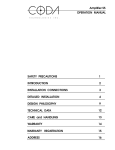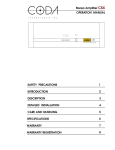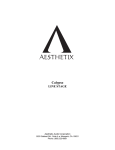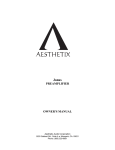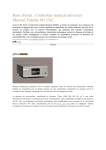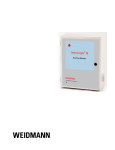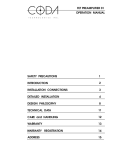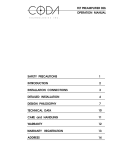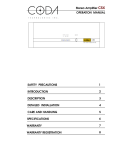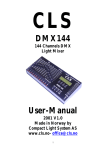Download Coda 05X Specifications
Transcript
Stereo Preamplifier 05X OPERATION MANUAL T E C H N O L O G I E S I N C . CH SELECTOR BALANCED COMPACT DISC TUNER VIDEO MONO MONITOR PROCESSOR VOLUME/BALANCE dB LEVEL VOLUME/BALANCE O5r LINE CONTROL BUFFER MAIN LEFT RIGHT SAFETY PRECAUTIONS 1 INTRODUCTION 2 INSTALLATION CONNECTIONS 3 DETAILED INSTALLATION 4 DESIGN PHILOSOPHY 5 SPECIFICATIONS & TECHNICAL DATA 6 CARE and HANDLING 7 WARRANTY & REGISTRATION 8 SAFETY PRECAUTIONS 1 CAUTION WARNING ! CAUTION: TO PREVENT ELECTRIC SHOCK, DO NOT REMOVE COVER. NO USER SERVICEABLE PARTS INSIDE, REFER SERVICING TO QUALIFIED SERVICE PERSONNEL. THIS SYMBOL IS TO ALERT YOU OF THE PRESENCE OF UNINSULATED DANGEROUS VOLTAGE WITHIN THE UNIT'S ENCLOSURE THAT MAY BE OF SUFFICIENT MAGNITUDE TO CONSTITUTE A RISK OF ELECTRIC SHOCK. ! THIS SYMBOL IS INTENDED TO ALERT YOU OF THE PRESENCE OF IMPORTANT OPERATING AND MAINTENANCE INSTRUCTIONS IN THE LITERATURE ACCOMPANYING THE UNIT. WARNING: TO PREVENT FIRE OR SHOCK HAZARD, DO NOT EXPOSE THIS UNIT TO RAIN OR MOISTURE. TO AVOID ELECTRICAL SHOCK, DO NOT OPEN THE UNIT. REFER SERVICING TO QUALIFIED PERSONNEL. CAUTION - Never install or remove the power cord from the chassis unless it has been disconnected from the AC power source first. Never pull on the power cord when removing it from an AC power source. Grasp it by the plug. Do not leave the power cord connected to an AC power source unless it is connected to the unit. It is recommend that during extended periods of nonuse that the units power cord be unpluged from its AC power source. Route the AC power cord so that it will not be damaged or walked on. INTRODUCTION 2 III. Installation and Setup This preamplifier is a precision device, designed in an effort to provide the listener with unmatchedsound quality, design, and construction. In order tooperate your preamplifier properly and to realize all of the capabilities of the 05X CONTROL PREAMPLIFIER , we recommend that you read this entire manual carefully, CH SELECTOR BALANCED COMPACT DISC TUNER VIDEO MONO MONITOR PROCESSOR VOLUME/BALANCE dB LEVEL VOLUME/BALANCE O5r LINE CONTROL BUFFER MAIN LEFT RIGHT INSTALLATION CONNECTIONS 3 Basic Configuration & Setup The first section of the installation instructions for the 05X CONTROL PREAMPLIFIER is a diagram of the basic configuration required to bring the preamplifier into an operating mode, These brief steps will allow you to begin operating your system. Make sure during installation that the AC power connections are interrupted to the preamplifier and all other components are off. While the diagram may be self explanatory, we strongly recommend that you read the detailed instructions following this introductory section. DETAILED INSTALLATION 4 1. The CH SELECTOR set of buttons selects the input source. 2. The MONO button commons the left and right channels. 3. The MONITOR button switches in a recording device (tape deck, CD-R, etc.). 4. The PROCESSOR button switches in a audio processor (surround sound processor,equalizer, ect.). 5. Volume and balance setting is indicated by the decibel (dB) display. FOR VOLUME ADJUSTMENT: The volume display shows "relative" volume level. When the display reads "99" there is no decibel attenuation, "00" is the maximum decibel attenuation, andlevel changes occur in 1dB increments. FOR BALANCE ADJUSTMENT: In the window next to the number display are three iindicator LEDs, MAIN, LEFT, and RIGHT. In the MAIN mode (blue LED) the display readout shows volume level. In the LEFT mode (white LED) the display readout shows lleft balance level. In the RIGHT mode (red LED) the display readout shows right balance level. In addition the display will flash on and off when the volume is muted. When adjusting individual channel level for balancing purposes, the display shows "actual" decibel level. In other words, the default value of "0" on the LEFT or RIGHT channel mode, shows that the channel is not attenuated. A value of "99" shows the channel is -99 db below full volume. 6. The VOLUME/BALANCE is controlled by the optical encoder control . Clockwise rotation increases level, counter clockwise rotation decreases level. Left balance is selected by pressing the knob once, and adjusting the level. Right balance is made by pressing the knob again, and adjusting the level. Pressing the knob once again will bring it back to being a volume control. 7. To adjust the GAIN of each input ( to match the levels of all the components in the system), press and hold its selector button while you press the volume knob - then release them both. The display will switch to "00" and the selected input light will flash. Turn the volume knob clockwise to raise the input gain up to +18db or turn counter clockwise to reduce the input level up to -99 db (note that the signs "-"or "+" are not displayed). To switch back to MAIN, press any button or the knob, or wait fifteen seconds. 1 2 3 4 5 6 CH SELECTOR BALANCED COMPACT DISC TUNER VIDEO MONO MONITOR PROCESSOR VOLUME/BALANCE dB LEVEL VOLUME/BALANCE O5r LINE CONTROL BUFFER MAIN LEFT RIGHT DETAILED INSTALLATION 4 Remote Control Functions The 05X Control Preamplifier may be operated by remote control. The Universal Remote Osiris MX-350 Programmable Remote Control is included for maximum system flexibility with your existing audio/video system. Please refer to the diagrams below for a detailed listing of remote functions. The Osiris remote control manual should be consulted for all other nonCoda programming and use functions. MAIN PAGE REMOTE PAGE KEYS PRESS TO SELECT 05X CONTROL MODE VOLUME 05X PAGE 1 05X PAGE 2 INPUT SELECT REMOTE PAGE KEYS Balanced MISC FUNCTIONS Tape Monitor Compact Disc Processor Loop Tuner Mono Video BALANCE ADJUST BALANCE ADJUST DESIGN PHILOSOPHY 5 5.1 Design Philosophy and Approach The circuity used in the FET CONTROL BUFFER 05x is the result of an advanced and complete design process combining innovation and prove fundamentals. This process avoids both the limitations of total adherence to convention and the flaws resulting from inappropriate applications of clever circuit gimmicks. Impedance isolation and matching is derived from FETs. While careful design can yield good results from any device type, FETs consistently have the edge in voltage gain, low noise, low interaction, and interface applications. FETs are inherently transconductance devices, meaning that an input voltage controls an output current. Unlike conventional transistors, FETs have extremely high input impedance ( about 10 meg ohm - similar to vacuum tubes ). The FET "senses" the audio signal without drawing current from the source. This eliminates complex interactions with the source, allows maximum performance from each system element, and greatly reduces the chance of cable characteristics altering the sound. The absence of input current in FETs allows high bias currents for linearity and speed without sacrificing DC parameters. Noise is kept low by multiple paralleling of input devices, careful selection of circuit impedances, and pre-screening of devices. The Class A complimentary followers used to drive the preamp output are of such speed, linearity, and low output impedance that no feedback correction is required or used. The advantage of this is that the circuit's perfect stability and transient response are preserved into a wide range of difficult and unpredictable loads. Variation in sound, which could occur through interactions with interconnect cables and other system elements are thus avoided. Until recently, perfect volume controls ( attenuators ) did not exist. This is because conventional stereo potentiometers have serious channel mistracking ( 20% typically ), become noisy with age, wear out, and have poor resolution of level - particularly when operated by a motor as required for remote operation. In an attempt to solve these problems, many manufacturers have been using "switched attenuators", which are discrete, resistor ladders built on rotary switches. But while these eliminate channel mistracking, they introduce new problems, including limited resolution, stepping transients, and cannot be operated remotely. And they still wear out. They limit resolution because the most contacts available on rotary switches are thirtyone. This requires two or three dB steps in order to get enough range out of the attenuator, which isn't a fine enough resolution for most listeners. Switched attenuators also introduce switching transients ( a "click" or "pop" ) each time the change positions. This noise comes from two sources. The first is mechanical noise from the switch itself as its ball-detent mechanism moves from detent to detent. But a more troublesome source is the voltage difference caused by the change in the musical waveform during the time it takes the switch to move from one position to the next. The greater the voltage difference, the louder the transient. DESIGN PHILOSOPHY 5 5.1 Design Philosophy and Approach - continued The circuity used in the FET CONTROL BUFFER 05x is the result of an advanced and complete design process combining innovation and prove fundamentals. This process avoids both the limitations of total adherence to convention and the flaws resulting from inappropriate applications of clever circuit gimmicks. Impedance isolation and matching is derived from FETs. While careful design can yield good results from any device type, FETs consistently have the edge in voltage gain, low noise, low interaction, and interface applications. FETs are inherently transconductance devices, meaning that an input voltage controls an output current. Unlike conventional transistors, FETs have extremely high input impedance ( about 10 meg ý - similar to vacuum tubes ). In other words, the FET "senses" the audio signal without drawing current from the source. This eliminates complex interactions with the source, allows maximum performance from each system element, and greatly reduces the chance of cable characteristics altering the sound. The absence of input current in FETs allows high bias currents for linearity and speed without sacrificing DC parameters. Noise is kept low by multiple paralleling of input devices, careful selection of circuit impedances, and pre-screening of devices. The Class A complimentary followers used to drive the preamp output are of such speed, linearity, and low output impedance that no feedback correction is required or used. The advantage of this is that the circuit's perfect stability and transient response are preserved into a wide range of difficult and unpredictable loads. Variation in sound, which could occur through interactions with interconnect cables and other system elements are thus avoided. Until recently, perfect volume controls ( attenuators ) did not exist. This is because conventional stereo potentiometers have serious channel mistracking ( 20% typically ), become noisy with age, wear out, and have poor resolution of level - particularly when operated by a motor as required for remote operation. In an attempt to solve these problems, many manufacturers have been using "switched attenuators", which are discrete, resistor ladders built on rotary switches. But while these eliminate channel mistracking, they introduce new problems, including limited resolution, stepping transients, and cannot be operated remotely. And they still wear out. They limit resolution because the most contacts available on rotary switches are thirtyone. This requires two or three dB steps in order to get enough range out of the attenuator, which isn't a fine enough resolution for most listeners. Switched attenuators also introduce switching transients ( a "click" or "pop" ) each time the change positions. This noise comes from two sources. The first is mechanical noise from the switch itself as its ball-detent mechanism moves from detent to detent. But a more troublesome source is the voltage difference caused by the change in the musical waveform during the time it takes the switch to move from one position to the next. The greater the voltage difference, the louder the transient. DESIGN PHILOSOPHY 5 5.2 Parts Quality and Evaluation 1. Finishes - All exterior and interior metal parts are anodized. While paint may be more impact resistant, the anodized surface is more resistant to solvents and prevents corrosion. Moreover, the anodized parts' appearance can be enhanced by either graining or bead-blasting the surface. 2. Circuit Board - Circuit boards are fiberglass epoxy with gold plating over a tin/nickel barrier. This gold layer will not corrode, while the barrier plate prevents the gold from migrating to the lower copper layer and detracting from its appearance. 3. Resistors - All are high reliability metal film 1% resistors. 4. Capacitors - All capacitors are of high quality. The only electrolytics used are in the power supply where large numbers provide enormous filtering capacitance for the supply. 5. Semiconductors - There are no integrated circuits (IC) to be found in the circuit path. Very high quality dual FETs are the only source of voltage gain and were selected for their superb noise performance and precision matching. The remaining semiconductors are also of very high quality, each possessing parameters ideally suited for the specific application. 6. Connectors - Coda employs a standard RCA configuration with a gold plated case. The balanced connectors are Neutriks from Switzerland. 7. Wire - All signal wire has been eliminated whenever possible. Where wire is used, Coda employs silver plated copper, 141 strand, 18 guage wire with a silicone insulation. SPECIFICATIONS & TECHNICAL DATA 6 Circuit Performance Specifications Frequency Response: -3db at 5 Hz and 200 kHz - Distortion: < .01 % from 10 Hz to 40 kHz @ 5V peak into 600 Ohms or higher, shunted by 1000 pF or less . Gain: Unity or independently variable on all inputs up to +18db in 1 db steps Maximum Output: 10 Volts peak Noise: > 100 dBA referenced to 1 Volt output Input Impedance: 20 k Ohms balanced or unbalanced Output Impedance: 50 Ohms non-reactive unbalanced 100 Ohms non-reactive balanced Crosstalk: 90 dB @ 20 kHz X Series Enhancements Ultra High Class A Bias on Parralled FET Output Buffer - 500% Higher Bias level than 05r/e Carefully selected and evaluated audiophile grade parts - rigorously tested by both and objective methodologies by our development team. Parts used in critical signal path and power supply applications include PRP & Holco Audio Resistors, Black Gate, Nichicon, and RelCap capacitors, Fairchild Stealth fast recovery diodes, Vampire pure copper RCA connectors. Includes the latest Burr-Brown PGA2320 SMA Digitally Controlled Attenuator, offering the lowest distortion (.0004 THD) and interchannel crosstalk (-126db) spec offered in such a device. New microprocessor control and learning remote, offering increased functionality. Power Supply Specifications regulated with shielded toroidal transformer and 19,800 uf of low-ESR cpacitance and bypassed Black Gate electrolytics smoothing the regulator outputs. Dimensions Height: . . . . . . . . . Width: . . . . . . . . . Depth: . . . . . . . . . Weight: . . . . . . . . . Power Consumption: . 1.75" Faceplate, 2.35" Overall 17.75" Faceplate, 17.0" Chassis 9.75" Overall 14.0 lbs. Shipping 10 Watts CARE and HANDLING 7 The interior of the unit requires no special care, due to the use of sealed controls and gold plating on contacts. If it becomes necessary to clean the exterior, a simple dusting may be all that is required. If a cleaner is necessary, any dilute commercial ammonia based product will be appropriate. NEVER use any abrasive rags, cleaners or chemical solvents on the preamp. When handling the unit, take care not to mar the aluminum. Aluminum is a medium hardness metal and can be scratched by the harder tool steels. Avoid exposing the unit to direct sunlight, and keep it away from sources of intense heat. Do not throw away the carton or associated packing material. They are ideal if you need to pack the unit for moving, and in the unlikely event that servicing is needed, they will be necessary for safe shipment. Be sure to provide adequate insurance when shipping. WARRANTY I. Warranty- Any failure of Coda products to operate or to meet specifications, applicable at time of manufacture, due to a manufacturing defect or component failure, will be corrected by Coda Technologies, Inc. without charge for parts, or labor for a period of ten years from date of original purchase. Coda Technologies, Inc. will provide for surface transportation to the Coda factory from an authorized Coda Technologies, Inc. authorized dealer for a period of one year from date of purchase. Maximum term for any warranty claim shall be ten years from date of original sale, or 11 years from date of manuafacture, whichever is shorter. Date of manufacture shall only be defined only manufacture date imbedded in serial number of product. Warranty shall be transferrable for a period of five years from the date of purchase. Subsequent owners are required to provide proof of sale/transfer from the original owner. Original owner may transfer warranty for the entire period of the warranty. Coda Technologies reserves the right to make the final determination as to validity of warranty claims in cases where ownership or manufacture date is not clear and substaniated in writing. II. Procedure- If the product should require service under warranty, take it with proof of purchase date, with its carton and packing material, to a Coda Technologies, Inc. dealer. The dealer will arrange for service. Direct shipments to the factory will be not be accepted without advance written authorization (RMA). Coda products purchased outside of the U.S. will be covered by those warranty conditions extended by the importing distributor which may differ in some respects from those given above. Warranty service, if required, is the responsibility of the importing distributor. If a Coda Technologies, Inc. product is removed from the country of original purchase, Coda Technologies, Inc. distributors or dealers are not obligated by the conditions of this warranty and repairs will be affected at their discretion. III. Exclusion of Coverage- At the sole opinion of Coda Technologies, Inc. the following situations are specifically excluded from coverage: 1. Any product not operated in accordance with the instructions contained in this manual, or otherwise subjected to abuse, tampering, modification, accidental damage, or serial number defacement. 2. Damage to other property caused by any defects in this product, damages based upon inconvenience, loss of use of the product, loss of time, commercial loss, or any other damage whether incidental, consequential, or otherwise. 3. It is Coda Technologies, Inc. policy to extend coverage when reasonable doubt exist; however, freight and diagnostic charges will be billed for any units returned under warranty and found by the company to be operating according to specification. This warranty gives you specific legal rights, and you may also have other rights which vary from state to state. Coda Technologies, Inc. continually researches new techniques, designs, and construction methods and so reserves the right to introduce refinements into current product lines without notice or obligation. The company may offer product modifications to make these refinements available to earlier production units. WARRANTY REGISTRATION Fill in and retain this copy of the warranty registration sheet for your records . To validate your registration, please call, mail, email, or FAX a copy of this registration to Coda at 916.386.8296 within 30 days of date of purchase. Please include proof of purchase with your submission. MODEL DESIGNATION:__________________________________ SERIAL NUMBER:______________________________________ DATE OF PURCHASE: PLACE OF PURCHASE Dealer:___________________________________________ Address:__________________________________________ City:_____________________ State:____ Zip:__________ Phone:____________________________________________ PURCHASER Name:_____________________________________________ Address:__________________________________________ City:_____________________ State:____ Zip:__________ Phone:____________________________________________ NOTES: 7850 CUCAMONGA AVENUE #34 SACRAMENTO, CA 95826 USA T E C H N O L O G I E S I N C . phone +01 916.383.3653 fax +01 916.455.3653 on the web at CODA.CC email us at [email protected]














